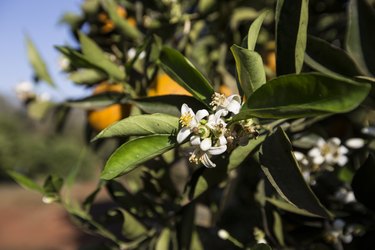
Believe it or not, orange seeds are thought to grow trees that produce sour oranges, so gardeners and growers prefer using orange tree cuttings. Orange trees can be propagated from branch cuttings as long as the cuttings are taken during the late spring or early summer. To increase the chances for success, a rooting hormone powder should also be used.
Orange Tree Branch-Cutting Basics
Video of the Day
Experienced orange tree growers understand that orange tree cuttings are an excellent option when it comes to growing new trees. However, the branches must be harvested at the right time of year. In addition, cutting and planting the branches the right way and using rooting hormone powder are the best ways to achieve successful root development. Pick healthy, mature orange trees with branches that are slightly wooded.
Video of the Day
When it comes to rooting powder, note that such products are also good for preventing diseases. You'll be able to plant the trees outdoors provided that you live in a USDA plant hardiness zone that would allow for their growth.
It is best to use a healthy, mature orange tree for cuttings. Experts recommend choosing trees that are around one to two years old. Look for branches that aren't too soft and pliable; they should have some woody substance to them. Cut four to five branches from different parts of the tree using a sharp knife.
Preparing Orange Tree Cuttings
Once you have the branches that you plan to use to grow new orange trees, you will need to prepare them for planting. Begin the process by trimming the branches so that they are 8 to 10 inches long. Then, make three to four vertical cuts at a 45-degree angle, as this is the best way to encourage strong root production. Remove any remaining leaves and dip the bottom two-thirds of each branch in a root growth hormone solution. Alternatively, if you prefer, you can add root hormone powder on the bottom third of the branches.
If you aren't familiar with rooting hormone powder, know that these chemicals stimulate new root growth on cuttings. While some cuttings root easily in water, others do not. Root growth hormones encourage root development, and some also contain fungicides and other ingredients to give the cuttings an even better chance of propagating.
Planting the Cuttings
The branches can be planted in pots filled with soil mixes that are equal parts perlite and sand, turf soil or plain sand. Once the pot is filled, dampen it and make a hole that is 1 inch deep. Plant several cuttings in one pot to increase the chance for success. Water thoroughly and place the entire pot with the cuttings into a plastic bag.
Keep checking the cuttings to ensure that the soil or sand is moist and add water if necessary. Make cuts in the plastic with a knife every day to gradually acclimate the cuttings to natural humidity. Remove the plastic after a week and keep watch. You will be amazed at how well rooting hormone powder works; there should be visible roots after about eight weeks or so.
These seedlings can be transplanted into larger pots after 12 to 14 weeks. Keep them indoors until the first winter has passed. You may be able to plant them outside before then but only if your region has mild winters. You can check the USDA plant hardiness zone map for more details.